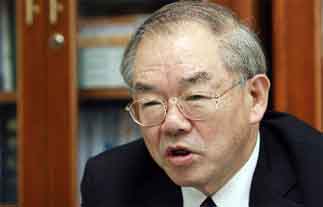[In depth interview]New Kaist president making bold changes

Suh Nam-pyo
On leave from the Massachusetts Institute of Technology, where he has been a mechanical engineering professor since 1970, he returned to Korea in July 2006 to become the head of Kaist.
He immediately began major structural changes at the country’s premier institution for science and technology education.
Recently, he denied tenure for 15 out of 35 professors who applied.
It is seen as a clear signal of how serious he is about restructuring Kaist.
The candidates had been pre-screened, with the president warning early on that the tenure process this year would be stricter.
The impact of this new policy was felt in the entire Korean academic community, not just in Kaist.
The faculty is one of many ways how Suh is trying to reform Kaist. Starting with this year’s freshmen, tuition fees will be based on academic grades.
For the 2008 admission process, creativity, leadership and personality will be more emphasized. Some call it “Suh’s school revolution.”
The Kaist president was interviewed by the JoongAng Ilbo on Oct. 12 at the National Assembly.
Q. Why are you visiting the National Assembly?
A. To ask for more money for the coming year. We have prepared a five-year project to compete with MIT. To win, we have to add 300 more professors to the current 400 and the annual budget also has to be doubled from the current 110 billion won ($120 million). But at least an additional 20 billion for next year would be a good start for Kaist to compete with MIT, which has 1,000 professors and an annual budget of $2.6 billion.
How can Kaist compete with MIT?
It is difficult to compete in every area, so we will decide on certain strategic areas and raise those fields to global standards.
We have decided to focus on the biggest issues of the 21st century, EWS ― energy and the environment, water and sustainability. For the national income to double, more knowledge must come from EWS-related areas. Industries in those fields must also grow.
What is your plan?
We have planned a new 82-acre campus focused on EWS to be built in the Songdo or Cheongra area in Incheon’s new free economic zone. To become a global school, Kaist needs to build an international network, but Daejeon is limited. The EWS campus will have half of its faculty recruited internationally and form active links with renowned schools in Germany or the United States to establish a science and technology network, which Kaist will lead. Without a global university a country cannot be a leader.
Your recent tenure decision was surprising.
It is natural at schools abroad. I told the younger professors that if they can’t raise top-class students from a very talented pool, it is a criminal offense. I also said a scholar must compete with history, which means a scholar must leave his mark in history. We need inherited abilities, but effort is what really counts. A university is not just a workplace.
The number of applications to teach at Kaist has increased by 50 percent. The president himself has to visit talented candidates, in Korea and abroad, to invite them to the school. I ordered the deans at Kaist to visit five schools abroad to meet prospective professors for Kaist. They will leave soon. You can’t just sit and wait for outstanding scholars to come. I also do some traveling. We need more financial resources, however. With just one or two world-class scholars, the school can gain prestige.
Some say Koreans tend to avoid engineering studies.
I have heard that, too. But Korea has about 70,000 engineering graduates a year, the same as the United States. The problem is education. At universities here, one engineering professor teaches 30 students on average. In elementary schools, a teacher has 27 pupils. At Kaist it is 10, graduate school included, but it is also bigger than the five students per teacher at Korean science high schools. I hear some universities make up the lack of professors with part-timers. The standard of engineering education has to be improved. Why wouldn’t students want to study engineering when the school is full of energy?
A large number of Korean scholars are not returning from studying abroad.
Korean schools are practically “feeder schools” to U.S. schools. We are just doing good for them. To learn advanced knowledge, studying abroad is important, but if students don’t return, how can Korean schools improve their research? At Kaist, however, 40 percent of the graduate students are Kaist undergraduates. A school becomes prestigious when it develops research ability. Kaist will increase the number of new students from 700 a year to 1,000 within two to three years. [Harvard and MIT admit about 1,000 to 1,500 a year. The number has to be at this level for a school to gain better research ability.]
What about support from Korean companies?
I want Korean companies to stop complaining that there aren’t any decent schools in Korea and to start supporting the schools. Korean companies give big sums to foreign schools, but little to domestic schools. For example, Stanford University gets billions of won [from Korean companies] while support is down in the hundred millions for Korean schools. After becoming president, I sent letters to Korean companies proposing joint research, but I haven’t got any replies yet.
Why did you establish a college of cultural science?
For a university to develop, the emphasis can’t only be on science and technology. Culture is a must. So I integrated the liberal arts and cultural technologies. Creativity comes from this integration.
By Oh Day-young JoongAng Ilbo [yhwang@joongang.co.kr]










with the Korea JoongAng Daily
To write comments, please log in to one of the accounts.
Standards Board Policy (0/250자)